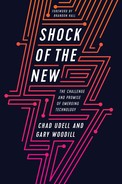FOREWORD
![]()
If you’re involved with technology for learning and development, you’re facing ever-increasing challenges with the selection and use of technology. This book will give you a multiyear look-ahead of the massive innovations and cool tools you may be asked to learn about and implement over the next five to 10 years.
Here’s the thing: Every few months, technology becomes more complex, more interconnected, and more embedded in your organization’s internal systems. The BUILDS framework presented here will provide you with a broad perspective you can use to evaluate the predicted as well as the largely unforeseen consequences of a new technology for your organization. You will learn to be a systems thinker; someone who is able to watch out for the concerns of the enterprise as well as those of individual learners—before unintended consequences appear.
How did you first get involved with technology for learning and talent?
I don’t know your route, but I’ll tell you mine. In the early 1980s, stories about Steve Jobs and the personal computer captured everyone’s attention. A cultural shift was happening and I wanted to be part of it. It was time to “Go West, young man,” so I picked up and moved to Silicon Valley. I soon bought my first computer, an Apple II. Oh, and then I bought $3,000 of stock in a little-known company named Intel. More on that later.
Besides my early connection with technology, I want you to know what I learned in my first Silicon Valley job with Wilson Learning Corporation. The company’s founder, Larry Wilson, was a great teacher and futurist, and he espoused beliefs that were very much related to the book you are holding. He got many of his ideas from another powerful source of the day: Alvin Toffler’s Future Shock. As a reminder, future shock is what happens when change is coming so fast that people are left confused and stressed, and normal decision making is no longer sufficient to deal with the complexities presented. Sound familiar?
That last part is key: normal decision making is no longer sufficient to deal with the complexities presented. And that’s the focus of this book. Shock of the New provides a framework for you to use to be mindful of the known and unknown implications—the unintended consequences—of new technology in your organization. This framework will help you become aware of more of the issues, make better decisions, and reduce your organization’s future shock, the shock of the new.
I am not aware of any other resources that will guide you in keeping the broader issues of technology selection in mind. You’ll find a 30-question scoring system for evaluating the selection of new technologies, which has been organized into six categories. The categories make up the authors’ BUILDS framework. You’ll then see this framework applied to six different emerging learning technologies, revealing the implications of technologies you’ll likely be dealing with soon.
It turns out that every new technology has far-reaching and often novel implications. The BUILDS framework uncovers an entire landscape of these implications and impacts that result from the technology choices you and your colleagues make today and will make tomorrow. It is to your advantage to look at these potential impacts from the broadest possible perspective. You need a way to see the bigger picture, and to be aware of unanticipated outcomes.
My friend and trusted colleague Gary Woodill and his co-author Chad Udell know more about current and future learning and development technologies than anyone else I know. Few people are as tech-savvy, future-aware, and broadly informed as Gary. He has the academic research rigor and persistence to gather all the relevant information to help you understand the topic at hand. His primary objective, for as long as I have known him, is to stay abreast of all the current and emerging trends in technology for learning. He is a technology futurist, and research-based at that. He knows what he is talking about.
Chad is cut from similar cloth. He’s unique in combining experience and training in design with one of the most innovative minds in technology. He’s truly on the leading edge of technology development, and deeply understands innovative software. As a side project, Chad designed and led a team to develop a smartphone app for people with visual impairments using computer vision, in a project funded by Google. He knows the future of technology and is developing learning apps using both augmented reality and virtual reality.
Future shock is not going away. Not only are bigger changes coming, but the rate, breadth, and magnitude of change is accelerating. And there’s no end in sight. There’s no future predicted for our lifetime where innovation will slow down and we’ll have a chance to get caught up, sort it all out, and fix all the problems. So, use the information in this book to help you and your organization deal with what is coming at you.
To bring this full circle, I spoke earlier of Steve Jobs. As you may know, Jobs started playing with computers while he was still in high school, where he met Steve Wozniak. Until a few years ago, I lived across the street from the house where Steve Wozniak grew up and where he tinkered with circuit boards in his garage. That house is gone, and Steve Jobs has passed on, leaving his mark. Today each of us carries the world’s knowledge in our pocket and life will never be the same for any of us, or our children.
Change continues. By the way, I sold that Intel stock after only a year. Today, as near as I can tell, it would be worth somewhere north of $10 million. (Sigh.)
You are one of the influencers for the best use of technology in your organization. Best of luck as you help reduce the shock of the new.
Brandon Hall, PhD
Executive Coach
Founder, Brandon Hall Group
